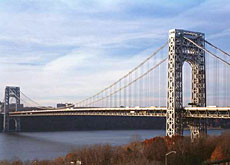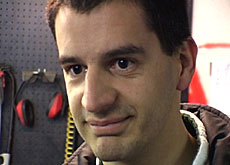Swiss bridge gap between engineering and art

The pioneering work of six Swiss engineers who rank as the most innovative structural designers of the twentieth century is being showcased in a new exhibition in the United States.
The exhibition at Princeton University aims to show how the group played a key role in transforming engineering into an art form.
David Billington, the show’s curator and a professor of engineering at Princeton, says some of the most acclaimed structures in the US are the work of Swiss design, including New York’s George Washington Bridge, designed by Othmar Ammann.
“The George Washington Bridge was about twice the span of any previous bridge of any type when it was built, so it was a great leap,” Billington told swissinfo.
“Ammann then went on to design all the other great bridges around New York, the most remarkable set of bridges ever designed by one person.”
Billington says Amman and his peers, Robert Maillart, Heinz Isler and Christian Menn, played a key role in the development of structural engineering, a term first coined during the Industrial Revolution when iron became a building material for bridges and other structures.
Ideology
The show, “The Art of Structural Design: A Swiss Legacy”, also features the work of Wilhelm Ritter and Pierre Lardy, who taught the group at the Zurich’s Federal Institute of Technology (ETH).
According to Billington, Swiss designers were way ahead of their American counterparts in part because of the brilliant teaching of Ritter and Lardy, but also because of Switzerland’s unique political position.
“The Swiss, unlike other European powers such as France and Germany, didn’t have a nationalistic ideology,” he says.
“So they got both the rigorous side of engineering from the Germans and the more aesthetic side from the French.”
Swiss bridges
Billington cites as examples models of two bridges in Switzerland – the Sunniberg and the Felsenau – designed by Menn, whom he regards as the greatest bridge designer practicing today.
“Menn thought that the haunches underneath [the Felsenau bridge] were a little heavy and that the columns were rather stiff and visually not very interesting,” he said.
“So with the Sunniberg bridge, he makes the deck extremely thin and the columns very finely shaped and open.”
The recently constructed Leonard P. Zakim Bunker Hill Bridge in Boston, also designed by Menn, is the widest cable-stayed bridge in the US.
Inspiration
Billington says a wider aim of the exhibition is to look at how the ETH could serve as a model for invigorating engineering in the US.
“Structural art comes out of the imagination of the engineer and involves basically three ideas,” Billington says. “One is efficiency in using minimal amount of materials. Second is economy. And third is elegance, designing based on the style of the designer.”
Billington hopes that in future, budding engineers will follow the Swiss example and study not only technical subjects but will also learn how to design öbjects of beauty.
swissinfo, Carla Drysdale in New York
An exhibition at Princeton University in the US is showcasing the work of six Swiss engineers.
They are Robert Maillart, Othmar Ammann, Heinz Isler, Christian Menn, Wilhelm Ritter and Pierre Lardy.
Swiss engineers were behind many important structures in the US.
“The Art of Structural Design: A Swiss Legacy,” is showing at Princeton University until June 15th.

In compliance with the JTI standards
More: SWI swissinfo.ch certified by the Journalism Trust Initiative








You can find an overview of ongoing debates with our journalists here . Please join us!
If you want to start a conversation about a topic raised in this article or want to report factual errors, email us at english@swissinfo.ch.